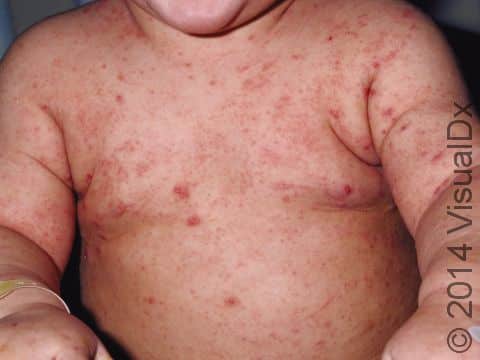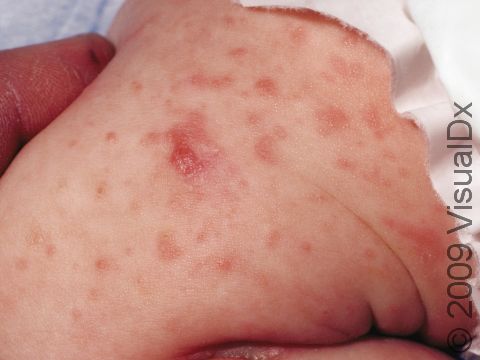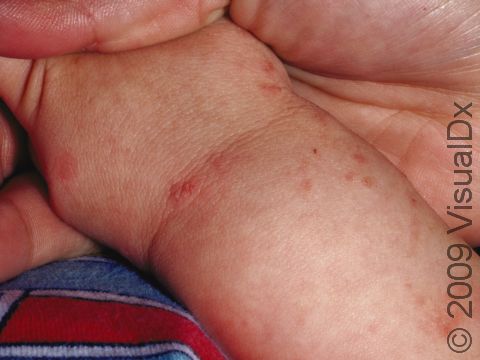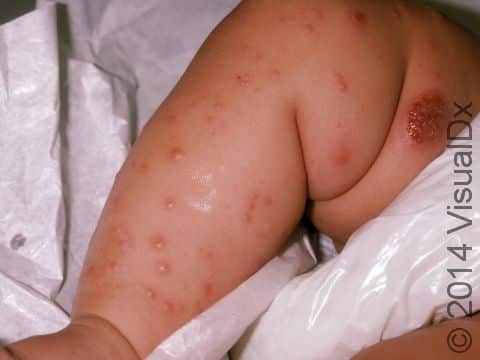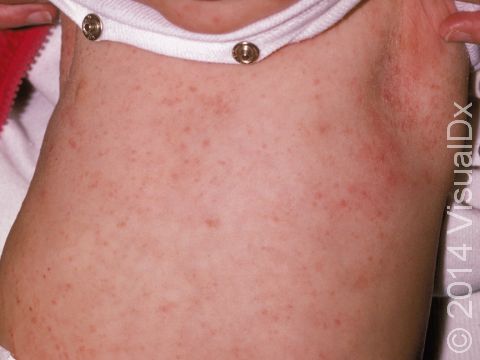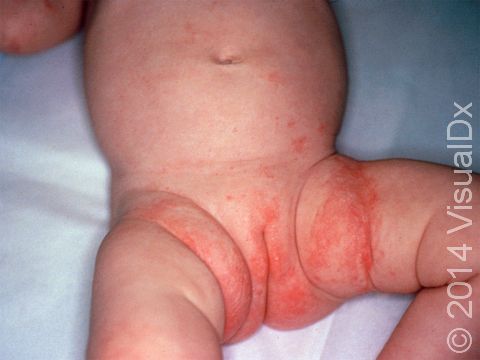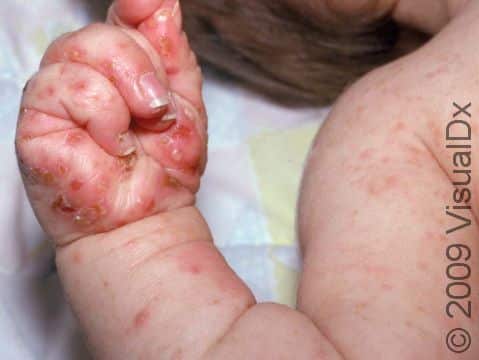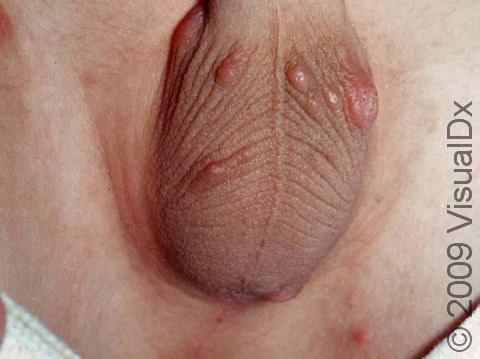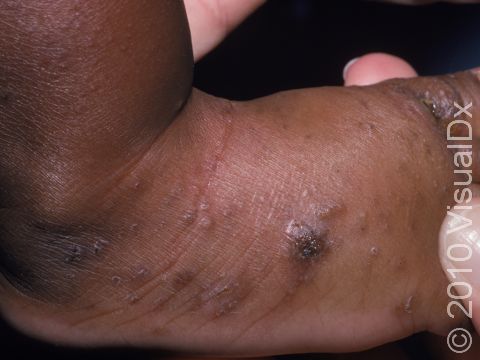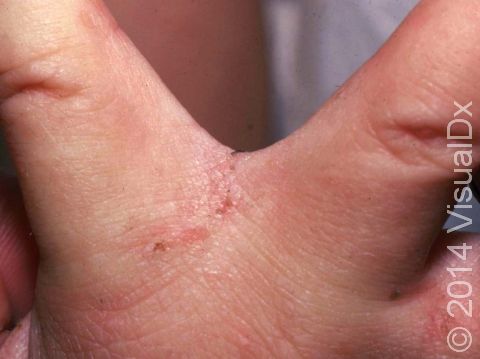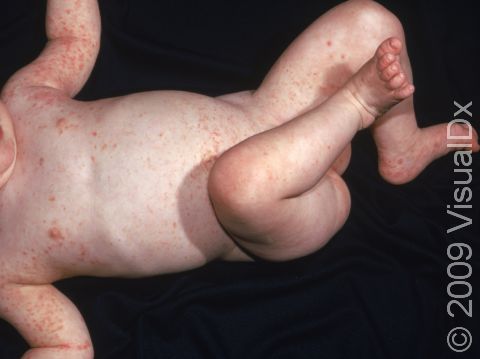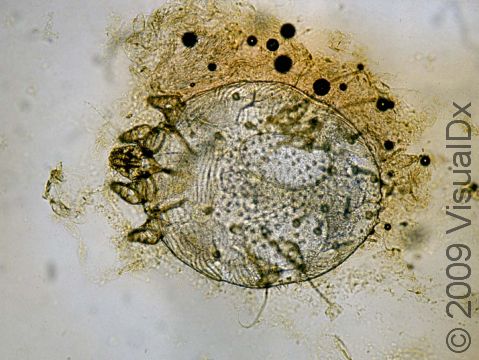Scabies (Pediatric)
Scabies is a common itchy rash seen in children and infants that is highly contagious. It is caused by a small bug known as a mite. (The scientific name of the mite is Sarcoptes scabiei.) The female mite typically enters the skin through skin folds, such as the space between the fingers, and burrows or invades the skin, forming a red “tract.” She then proceeds to lay eggs in the skin, which will later hatch into larvae. The first sign of a scabies infection (actually it is an infestation, but the two words tend to be used interchangeably for scabies) is usually several small (1–2 mm) red, crusty bumps on the hands and feet. The skin of infants is often more exposed and more sensitive, and, therefore, these lesions can develop into large blistering lesions or pus-filled bumps. Scabies is extremely itchy because the human immune system forms an allergic reaction to the mite and the eggs that hatch.
Who's At Risk?
Scabies can infect all populations. It is common among children and infants and can be spread rapidly through day cares, nurseries, and households. Scabies is spread through physical contact, and the more exposure you have to an infected person increases the risk for becoming infected yourself, which is why those living in the same household are particularly prone to becoming infected.
Typically the head, neck, palms of the hands, and soles of the feet are spared from the rash.
Signs & Symptoms
Although the entire body may itch, the most common locations for the lesions of scabies in older children and adults include:
- The areas between the fingers (finger webs)
- Inner wrists, inner elbows, and armpits
- Breasts of females and genitalia of males
- Navel (umbilicus)
- Lower abdomen
- Buttocks
- Backs of knees
In young children, the lesions of scabies are most commonly seen on the:
- Trunk, arms, and legs
- Head and neck
- Palms of the hands and soles of the feet
The most obvious signs of scabies are pink-to-red bumps, which can look like pimples or bug bites and may be scabbed from scratching. However, the tell-tale lesion of scabies is the burrow, which is small, subtle, and difficult to detect. Typically, a burrow appears as a fine, thread-like, scaly line (3–10 mm long), sometimes with a tiny black speck (the burrowing mite) at one end. When looking for burrows, it may help to use a 2- or 3-power magnifying glass.
Scabies is intensely itchy, especially at night.
Scratching the itchy lesions can create breaks in the skin, and these breaks can become infected with bacteria.
People who are exposed to scabies may not develop itchy lesions for up to 6 weeks after becoming infested, as the immune system takes some time to recognize the mites and develop an allergic response to them. However, individuals who have had scabies before may develop the rash within several days of re-exposure.
Self-Care Guidelines
Though scabies is extremely contagious, it usually requires prolonged skin-to-skin contact with a person already infested. A quick handshake or hug will not normally spread the infection. However, scabies is easily spread to sexual partners and to other members of the household. Less commonly, it may be spread by sharing towels, clothing, or bedding.
Scabies requires prescription medication in order to stop the infestation. Once your child is under a doctor’s care, there are steps you can take to prevent scabies from coming back:
- Mites cannot survive off the human body for more than 48–71 hours. Therefore, wash all clothing, bedding, and towels used by the infested person in the previous 72 hours in hot water and dry these items in a hot dryer.
- Vacuum all carpets, rugs, and upholstered furniture, and discard the vacuum bags.
Treatments
The physician may be able to diagnose scabies simply by examining your child’s skin for typical lesions such as burrows. A skin scraping, called a scabies preparation, may be examined under the microscope for mites, eggs, or mite droppings (feces).
In most cases of scabies, the doctor may recommend a topical cream or lotion, such as:
- Permethrin cream – Apply at night, and rinse off in the morning. Use the permethrin cream again in 1 week. Permethrin has been approved for use in infants aged 2 months or older.
- Crotamiton cream – Apply once daily for 2 consecutive days, and rinse off 48 hours after last application.
- Sulfur ointment – Apply nightly for 3 consecutive nights, and rinse off 24 hours after last application. This is often the best choice for babies and for pregnant and nursing women because it is very safe to use.
- Lindane lotion or cream – Wash the cream or lotion off after 8 hours. Lindane may be toxic to some people. Infants and young children should not be treated with lindane, nor should pregnant or breast-feeding women or people with diseases affecting the nerves (neurological diseases).
When using a topical cream, lotion, or ointment, be sure to follow these steps (unless the physician gives other instructions):
- Apply to the entire body from the neck down.
- Smear the product beneath your child’s fingernails and toenails.
- Apply to body folds, including inside the navel, in the buttock crease, and between the toes.
For more severe scabies, your child’s doctor may prescribe oral medications:
- Ivermectin pills – Take once and then repeat 1–2 weeks later. Ivermectin should not be used for children aged younger than 5 years or who weigh less than 15 kg (about 35 lb), or pregnant or lactating women.
- Antihistamine pill.
- Antibiotic pills – If any scratched areas appear to be infected with bacteria, your physician may prescribe oral antibiotics.
Itching may take up to 3 weeks to go away, as your child’s immune system continues to react to dead mites. However, new burrows and rashes should stop appearing 48 hours after effective treatment.
Your doctor should remind you to launder towels, bed linens, and clothes used by your child in the previous 72 hours and to vacuum carpets, rugs, and upholstered furniture.
Household members, sexual partners, and anyone else with prolonged skin-to-skin contact with an infested person should also seek treatment from their doctors. Since the initial development (incubation time) for scabies infestations can be from 6–8 weeks, people may be infected with scabies, but since they do not yet feel itchy, they are unaware that they have infestation. If untreated, these close contacts could pass the mites back to your child. Ideally, everyone should be treated at the same time in order to prevent re-infestation.
Visit Urgency
See your child’s doctor for evaluation if he or she develops an extremely itchy rash. If other members of the household or your child’s close contacts have similar itchy rashes, make sure they are also evaluated by a physician.
References
ed. Dermatology, pp.1321-1324. New York: Mosby, 2003.
Freedberg, Irwin M., ed. Fitzpatrick’s Dermatology in General Medicine. 6th ed. pp.1374, 2283-2284. New York: McGraw-Hill, 2003.
Last modified on August 16th, 2022 at 2:44 pm

Not sure what to look for?
Try our new Rash and Skin Condition Finder
